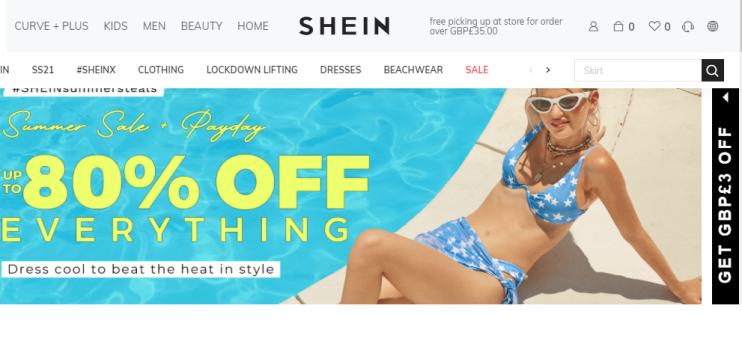Meet Shein: The secretive Chinese fast-fashion firm taking over online retail

Taking the Tube at the minute can still, at times, feel like time travel.
Around you are slightly tattered posters for theatre productions that haven’t been on stage for more than a year; ads for movies touted for cinema release that ended up quietly released to Netflix with little fanfare.
Amongst these relics of a pre-pandemic past are a host of new, rather brighter examples. Boohoo is everywhere. So are Pretty Little Thing, Something for the Weekend, and a host of other fashion brands.
The most prominent recently, however, is that of Shein – a womenswear focussed firm that seems to have arrived fully formed in the UK with an advertising campaign pegged on a collaboration with reality TV star turned it-girl novellist Georgia Toffolo.
The graphics are textbook fast fashion – sunny, vibrant and promising the life of the rich and famous for low, low prices. But Shein’s rise to the top of the pile-it-high and sell-it-cheap world of online shopping across the world is not without an element of mystery.
A global Chinese success story
Shein was founded in 2008 in China by Chris Xu, an SEO specialist with a peculiar penchant for getting his way to the top of search engine rankings. His fashion firm – SheInside, then – pioneered a particularly Chinese approach to retail once he moved from hawking wedding gowns to selling women’s apparel in 2012.
Rather than working predicting what consumers might want, he simply asked; posting thousands of product lines, Xu’s firm waited until there was sufficient demand and only then sourced the actual goods themselves.
The company flew. Xu bought production inhouse and plotted international expansion. A Series E funding round which closed in 2020 valued the firm at some $15bn, with Sequoia Capital China and Tiger Global Management chief amongst those piling in. And this month, reports in the States suggested it was now a bigger online retailer than H&M and Zara in the US. Gen-Z is Shein’s heartland, and one in which it’s made dramatic inroads, with online influencers at the heart of the marketing plan. So successful has it been that the firm even considered a bid for embattled Topshop in January, a sign of its increasing ambition in the UK.
But one question remains.
How do you sell it so cheap?
Even in a fast fashion world in which people rarely bat an eyelid at low prices, SheIn’s website is staggeringly cheap. Denim jackets for £19, dresses for the price of two London pints, handbags at below-Primark prices.

Can a smart supply chain really bring costs down to that level? The firm offers precious little transparency on who, or what, is behind the firm’s manufacturing processes.
Their main corporate website doesn’t even refer to the founder. The location of their factories is only something we can guess at – the only reference is to “globally positioned warehouses.”
And on the supply chain itself, Shein only says of itself that “advanced equipment and professional handiwork come into play.”
“When we visit the factories,” the website reads, “we sometimes lament the production-related inefficiencies. However, we are very pleased that through effective communication and cooperation, we are able to see shortened production cycles to release new products.”
Opacity in the fashion industry is not unique to Shein, but even by the standards of an industry well in need of the disinfectant of sunlight, it remains an enigma.
The Fashion Transparency Index, compiled by campaigners Fashion Revolution, gave Shein a total overall score of 1 out of 100 in a report compiled earlier this year. On traceability, one of the key metrics in the Index, Shein scored a zero.
Good on You, a fashion directory which also rates major fashion brands, is equally damning. Shein’s labour and environment rating is “very poor.”
“There is no evidence it has worker empowerment initiatives such as collective bargaining or rights to make a complaint. It sources its final stage of production from countries with extreme risk of labour abuse. There is no evidence it ensures payment of a living wage in its supply chain. It audits some of its supply chain but does not specify what percentage,” Good on You’s summary reads.
Fashion firms are under particular global pressure to be open about their supply chains – due to the outsized role Xinjiang, the autonomous area of China home to persecuted Uighur Muslims, plays in the global production of cotton.
Though denied by the Chinese authorities, most impartial observers believe Xinjiang is home to a network of forced labour and prison camps.
The Centre for Global Policy reckon some half a million ethnic minority Xinjiang residents have been coerced into picking cotton. Last year a coalition of human rights groups said “virtually the entire [global] apparels industry is tainted by forced Uighur and Turkic Muslim labour.”
Read more: US issues warning over doing business in China’s Xinjiang province
“Long, exhausting working hours”
Shein, which does not publicise a press office in the UK nor advertise who runs their operations in the UK, did not respond to requests from City A.M. for more information on their supply chain.
Fashion Revolution’s Sarah Ditty told City A.M. that Shein make it “difficult for anyone on the outside to know what they’re doing.
“The main concern with ultra-fast-fashion companies like this — and Shein isn’t the only company producing thousands of styles a week — is the lack of information. There’s a history of long, exhausting working hours for some garment workers,” she says.
“The prices are a huge red flag. How do you pay your workers when you’re selling so cheaply? We love ‘retail therapy’ to make ourselves feel good but the reality can be tragic. Worst-case scenario: People are buying into forced or child labour and human trafficking without realising.”
A statement on Shein’s corporate social responsibility page says the firm has a “strong belief in ethical working conditions for all workers” and that “neither we nor any of our partners are allowed to use forced labour.
“We actively campaign against unethical practices such as prison and indentured labour,” continues the statement, though there is no evidence provided.
The statement also says Shein “strictly abides by child labour laws in each of the countries we operate in” and that “any partners or vendors found to have violated these laws are terminated immediately and reported to the authorities.”
As a firm operating in the UK with a turnover north of £38m, Shein are obliged under the Modern Slavery Act to file a document detailing the work they are doing to identify and eradicate modern slavery in their supply chains. Firms are invited to file their records publicly, including on a searchable Government registry. At the time of writing, Shein’s statement had not been submitted to that registry.
The Government has committed to make the publication of modern slavery documents on that registry mandatory in the future as part of a strengthening of modern slavery legislation.

An industry-wide problem
The collapse of the Rana Plaza factory in 2013 – in which more than 1,000 Bangladeshi garment workers died – and the exposure of heinous working conditions in a Boohoo factory in Leicester last year brought home fast fashion’s social impact.
Yet though progress has been made, only half the major brands in the Fashion Transparency Index disclose their suppliers, and only just over one in ten reveal where they source their materials.
“The reason why brands are still failing to disclose this information is because they haven’t mapped their supply chain and don’t know where their products are manufactured, or because they simply don’t want to be accountable,” says Ditty.
“Some brands claim they do not want to disclose their supply chain for commercial reasons, but more than a hundred major brands publish their suppliers so this is no longer an excuse,” she continues.
Read more: Boohoo urged to link bonuses to workers’ rights and sustainability improvements
Not just supply chains
Away from issues around transparency, the firm has not been without controversy.
Shein has run into a number of battles with independent designers who accuse the brand of ripping off their designs.
And the firm was forced to issue grovelling apologies on social media last year after first selling an Islamic prayer mat as a ‘Greek carpet’ and then selling a necklace with an image of a swastika.
Those apologies, posted unattributed to any individual from the firm’s social media accounts, are about the only piece of external communication the firm has mustered in recent years.
One thing we do know is that the firm benefitted from Donald Trumps’s trade war – tax breaks brought in by the Chinese government to help exporters gave its direct-to-consumer model a fair wind.
But whilst it’s easy to find information on how to become a #Sheingal influencer, information about the firm itself is far more challenging.
Shein may well be just one of a number of online-only fashion brands crashing the traditional retail space – but they are certainly the most secretive.
And it’s that that is riling campaigners.
Johnny Patterson, the Policy Director of human rights campaigners Hong Kong Watch and founder of ethical fashion brand Yesfriends, told City A.M. that the lack of transparency at the heart of Shein is “alarming.”
“The brand’s opaque, ghost-like PR strategy may be explained by the fact that it would prefer not to answer tricky questions like this, or about its environmental footprint. But the Government has a duty to engage,” he said.
“It is actively damaging to ethical and sustainable brands when fast fashion players with no transparency artificially undercut the market through abusive labour practises. Shein must demonstrate that it does not fall into this camp. If it fails to improve its transparency, serious questions should be asked,” he continued.
A number of email addresses attached to the Shein website were contacted as part of this piece, in addition to an email address believed to belong to a member of senior management, and a LinkedIn message sent to an individual purporting to be a member of Shein’s senior management in the UK. None were responded to.